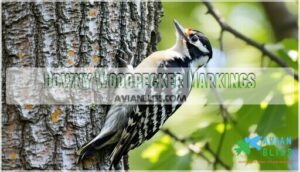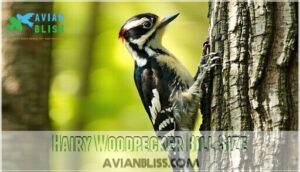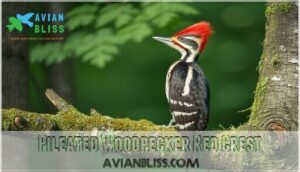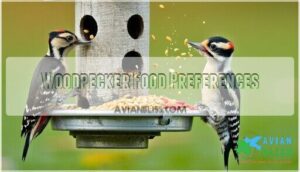This site is supported by our readers. We may earn a commission, at no cost to you, if you purchase through links.
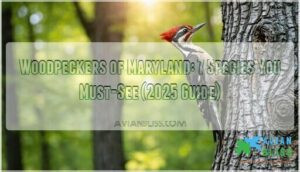
These remarkable birds range from ground-foraging Northern Flickers to tree-drilling Yellow-bellied Sapsuckers that tap over 1,000 tree species for their sweet sap meals.
Each species displays unique behaviors and habitat preferences that make identification straightforward once you know what to look for, revealing fascinating insights about successful backyard birding strategies and the specific field marks, feeding habits, and seasonal patterns of Maryland’s woodpecker community.
Table Of Contents
- Key Takeaways
- Woodpeckers of Maryland
- Maryland Woodpecker Species
- Woodpecker Habitat Preferences
- Identifying Maryland Woodpeckers
- Attracting Woodpeckers to Yards
- Frequently Asked Questions (FAQs)
- What is the small black and white woodpecker in Maryland?
- What is the difference between a downy woodpecker and a sapsucker?
- What woodpecker has a red head in Maryland?
- Are woodpeckers good to have in your yard?
- How many woodpecker species are found in Maryland?
- What is the typical woodpecker diet?
- How do woodpeckers build their nests?
- Do woodpeckers migrate?
- How do woodpeckers benefit the ecosystem?
- Do woodpeckers damage healthy trees in Maryland?
- Conclusion
Key Takeaways
- You’ll find Maryland’s seven woodpecker species range from the massive Pileated Woodpecker to the tiny Downy Woodpecker, each with distinct field marks and behaviors that make identification straightforward once you know what to look for.
- You can attract multiple woodpecker species to your yard by offering suet feeders, maintaining dead trees for nesting sites, and providing water sources near mature native trees like oak and maple.
- You’ll spot unique feeding behaviors among Maryland’s woodpeckers – Northern Flickers forage on the ground for ants, Yellow-bellied Sapsuckers drill rows of holes for tree sap, and Pileated Woodpeckers excavate rectangular cavities in dead trees.
- You’ll benefit from having woodpeckers in your yard since they’re natural pest controllers that consume harmful insects like carpenter ants and wood-boring beetles while creating nesting cavities that support over 40 other bird species.
Woodpeckers of Maryland
Maryland’s seven woodpecker species offer remarkable diversity for birdwatchers, from the crow-sized Pileated Woodpecker to the sparrow-sized Downy Woodpecker.
You’ll find these fascinating birds in various habitats throughout the state, each displaying unique behaviors and distinctive field marks that make identification both challenging and rewarding, with the overall experience being a remarkable diversity.
Pileated Woodpecker Characteristics
You’ll recognize the Pileated Woodpecker as Maryland’s largest woodpecker species, standing out with its impressive Physical Size and distinctive red Crest Morphology.
This powerhouse of Habitat Engineering excavates rectangular holes in dead trees, reshaping forest ecosystems.
These master architects carve out nature’s apartments, creating homes for countless forest neighbors with every powerful strike.
Their Diet Preferences focus on carpenter ants and wood-boring beetles.
Listen for their loud, irregular drumming and wild Vocalizations echoing through mature forests—unmistakable among Maryland woodpeckers.
These woodpeckers typically form lifelong pair bonds.
Northern Flicker Habits
You’ll spot the Northern Flicker’s unique ground foraging behavior distinguishing it from other Maryland woodpeckers.
This species exhibits fascinating habits that set it apart from typical tree-dwelling relatives. Northern Flickers create nests by excavating nest cavities in dead or diseased trees.
Key Northern Flicker behaviors include:
- Ground Foraging – They hammer into soil searching for ants, which comprise 50% of their flicker diet
- Flicker Sounds – Loud "kleer" calls and laughing notes establish territory and communicate with mates
- Nesting Behavior – Excavate cavities 6-15 feet high in dead trees, laying 5-8 eggs with 25-28 day fledging periods
Downy Woodpecker Identification
You’ll recognize the Downy Woodpecker as Maryland’s smallest woodpecker species, measuring just 5.5-6.7 inches.
Males display distinctive red patches on their head’s back, while females lack this marking.
Their compact bills distinguish them from similar Hairy Woodpeckers during woodpecker identification.
These common woodpeckers frequent Maryland backyards and parks, exhibiting gentle behavior patterns.
Listen for their soft vocalizations and observe their preference for smaller tree branches, making habitat clues easier to spot than larger species.
Red-bellied Woodpecker Distribution
You’ll find the Red-bellied Woodpecker thriving across Maryland’s diverse landscapes, from dense forests to suburban neighborhoods.
Red-bellied Woodpeckers adapt beautifully to Maryland’s changing landscapes, making suburban yards their new frontier.
This adaptable species has established a robust presence throughout eastern North America, with Maryland serving as prime habitat within its extensive range.
- Habitat Range: Occupies deciduous forests, oak-hickory stands, and urban parks throughout Maryland
- Population Density: Maintains stable populations with approximately 15 million birds across North America
- Urban Adaptation: Successfully colonizes suburban areas and backyard feeders, showing remarkable climate impact resilience
These birds are opportunistic feeders, consuming insects, fruits, and even small vertebrates.
Maryland Woodpecker Species
You’ll encounter three remarkable woodpecker species that showcase Maryland’s diverse avian community through their unique behaviors and adaptations.
The Hairy Woodpecker demonstrates exceptional insect-hunting skills in mature forests, while the Yellow-bellied Sapsucker follows predictable migration patterns from northern breeding grounds to southern wintering areas.
The Red-headed Woodpecker maintains stable population numbers despite habitat pressures.
Hairy Woodpecker Traits
The Hairy Woodpecker stands out among Maryland’s woodpecker species with its distinctive medium size and longer bill length compared to its smaller cousin, the Downy Woodpecker.
You’ll notice its striking black and white plumage details, including white undersides and barred wings.
This non-migratory species thrives in Maryland’s mature forests where its specialized insect diet focuses on wood-boring beetles found in dead trees.
Yellow-bellied Sapsucker Migration
Yellow-bellied Sapsuckers follow predictable migration patterns through Maryland from late September through April.
These state-specific bird species peak during early October and late March migrations along established bird migration routes.
Migration triggers include temperature drops and changing sapsucker diet availability.
You’ll spot them drilling characteristic sap wells during passage, as habitat impact drives their search for suitable wintering grounds across southern regions.
Red-headed Woodpecker Population
Maryland’s Red-headed Woodpecker population faces serious decline due to habitat loss and breeding success challenges.
Once common throughout the state, this woodpecker species now struggles against population threats including invasive starlings competing for nesting sites.
Conservation efforts target habitat preservation, but range expansion remains limited.
Current statewide bird population trends show continued decreases for this distinctive species despite ongoing protection initiatives.
Woodpecker Habitat Preferences
You’ll find Maryland’s seven woodpecker species in distinct habitats based on their feeding needs and nesting requirements.
These birds select specific forest types, tree species, and even backyard environments that provide the right combination of food sources and suitable nesting sites.
Forest Dwelling Woodpeckers
When you venture into Maryland’s mature forests, you’ll discover the true domain of forest dwelling woodpecker species.
The Pileated Woodpecker dominates these forest ecosystems, requiring large dead trees for nesting habits and carpenter ant diet sources.
Their ecological role as forest habitat engineers creates homes for countless species, making their conservation status vital for maintaining healthy woodpecker habitat in Maryland’s wilderness areas.
South Carolina, for example, is home to eight woodpecker species.
Backyard Woodpecker Attractions
Attracting backyard woodpeckers to your Maryland property requires strategic planning and specific resources.
Create an irresistible habitat by offering:
- Suet recipes and woodpecker feeders filled with high-energy foods
- Nesting boxes positioned on native trees for breeding pairs
- Water sources and bug attractants near feeding stations
This combination transforms ordinary yards into thriving woodpecker sanctuaries, supporting backyard birdwatching throughout Maryland’s seasons.
Consider using specialized suet feeders to attract more woodpeckers.
Woodpecker Tree Selection
Tree selection drives successful woodpecker habitats across Maryland’s diverse forests.
These remarkable birds demonstrate specific preferences when choosing nesting sites, with tree age and wood density serving as primary factors in their habitat availability decisions.
| Tree Characteristic | Preferred Condition | Woodpecker Benefit |
|---|---|---|
| Tree Age | 90+ years old | Softer excavation for cavity size |
| Wood Density | Fungal decay present | Easier nest construction |
| Insect Presence | High wood-borer activity | Enhanced foraging opportunities |
Woodpecker nesting success correlates directly with proper tree selection in Maryland forests, where woodpecker ecology depends on mature specimens for ideal woodpecker foraging conditions.
Identifying Maryland Woodpeckers
You’ll find identifying Maryland’s seven woodpecker species becomes straightforward once you learn their key distinguishing features.
Each species displays unique markings, bill sizes, behaviors, and physical characteristics that make field identification reliable with practice.
Downy Woodpecker Markings
You’ll easily recognize the Downy Woodpecker by its distinctive black and white plumage variations across Maryland woodpecker species.
Males display a bright red spot on their head’s back, while females lack this marking entirely.
Juvenile markings often show duller coloration than adults, and regional differences in Maryland remain minimal, though aberrant coloration occasionally occurs.
These clear field marks help you confidently identify woodpeckers when reviewing woodpecker images or observing these common backyard visitors throughout the state.
Hairy Woodpecker Bill Size
When comparing Hairy Woodpeckers to similar Maryland woodpecker species, you’ll notice their distinctively longer bill serves specialized feeding purposes.
This Bill Size Variation enables superior Insect Extraction from deep bark crevices through evolutionary Feeding Adaptations.
Key bill differences for woodpecker identification:
- Length comparison – Hairy Woodpecker bills measure nearly equal to head width
- Thickness factor – Robust construction supports intensive bark penetration
- Species Comparison – Noticeably longer than Downy Woodpecker’s shorter bill
This Woodpecker Evolution demonstrates how bill morphology directly correlates with hunting strategies across Maryland’s diverse woodpecker species.
Northern Flicker Ground Foraging
Unlike other Maryland woodpecker species that hammer tree bark, you’ll spot Northern Flickers hopping across your lawn like oversized robins.
Their unique woodpeckers have developed specialized foraging adaptations for ant consumption, using their curved bills to probe soil and grass.
Their flicker diet consists primarily of ground-dwelling insects, making habitat impact significant in suburban areas where urban foraging opportunities abound.
They’re also known to visit hummingbird feeders, attracted to sugar water.
Pileated Woodpecker Red Crest
Maryland’s massive Pileated Woodpecker displays the most striking crest coloration among state-specific bird species.
This triangular red crest serves multiple functions beyond identification. Crest development varies between sexes, with males showing additional red facial striping.
The crest display intensifies during territorial disputes and courtship behaviors.
- Brilliant crimson crest – covers entire crown from bill to neck
- Sexual dimorphism – males feature red cheek stripes absent in females
- Behavioral significance – crest raises during aggressive encounters
- Size comparison – largest crest among Maryland’s woodpecker facts
Attracting Woodpeckers to Yards
You can transform your backyard into a woodpecker haven by understanding what these fascinating birds need to thrive.
The right combination of food sources, proper feeder placement, and suitable trees creates an irresistible environment that draws Maryland’s seven woodpecker species right to your doorstep.
Woodpecker Food Preferences
What drives woodpecker food preferences in Maryland? Their diet varies seasonally, emphasizing insect consumption during breeding season and shifting to seed preferences, fruit diets, and sap drinking in fall and winter.
Maryland woodpeckers favor suet, sunflower seeds, and peanuts at feeders. Consider buying suet feeders designed specifically for woodpeckers.
Understanding these bird food preferences helps you make ideal feeder choices for attracting local species year-round.
Suet Feeder Installation
Proper feeder placement transforms your backyard into a woodpecker haven.
Mount suet feeders six feet high on sturdy poles with squirrel baffles below. Choose high-energy suet types containing nuts, seeds, and insects that attract Maryland’s seven woodpecker species.
Clean feeders weekly to prevent mold and guarantee woodpecker safety. Position feeders near trees but allow clear flight paths for easy access.
To maintain freshness, consider freezing suet cakes for later use.
Tree Selection for Woodpeckers
Beyond suet feeders, your tree choices determine which woodpecker Maryland species visit your yard.
Smart tree selection creates lasting woodpecker habitats that support native tree planting goals while attracting these remarkable birds to woodpecker Maryland forests near your home.
- Decaying Wood: Dead or dying trees provide prime nesting cavities and insect-rich feeding zones
- Native Trees: Oak, maple, and hickory species offer natural sap trees and familiar woodpecker habitats
- Tree Age: Mature trees with thick bark harbor more wood-boring insects than younger specimens
- Mixed Heights: Varying canopy levels accommodate different species’ foraging preferences and territorial needs
Creating Woodpecker-Friendly Environments
Creating productive woodpecker habitats requires careful attention to water sources and native trees.
You’ll attract more species by maintaining deadwood management practices and limiting insect control methods.
Install nesting boxes near mature oaks and maples while providing shallow water features.
Consider specialized nesting options to further encourage woodpeckers.
These woodpecker Maryland environments support bird attraction through strategic native tree planting and thoughtful bird feeder selection within established woodpecker habitats.
Frequently Asked Questions (FAQs)
What is the small black and white woodpecker in Maryland?
You’ll spot tiny feathered acrobats performing death-defying stunts on tree bark.
The Downy Woodpecker (Dryobates pubescens) is Maryland’s smallest black-and-white woodpecker, measuring just 5-7 inches with distinctive white bellies and spotted backs.
What is the difference between a downy woodpecker and a sapsucker?
You’ll notice downy woodpeckers are tiny with short bills, while yellow-bellied sapsuckers are larger migrants that drill neat rows of holes to drink tree sap.
What woodpecker has a red head in Maryland?
Picture a flash of brilliant crimson catching your eye through the forest canopy.
In Maryland, you’ll find the Red-headed Woodpecker with its completely red head, plus the Red-bellied Woodpecker sporting red on its crown and nape area.
Are woodpeckers good to have in your yard?
You’ll definitely want woodpeckers in your yard because they’re natural pest controllers that devour harmful insects like carpenter ants, wood-boring beetles, and grubs that damage trees and plants.
How many woodpecker species are found in Maryland?
Like discovering hidden treasure in your backyard forest, you’ll find seven distinct woodpecker species calling Maryland home year-round or seasonally, each bringing unique behaviors and characteristics to your local ecosystem.
What is the typical woodpecker diet?
Woodpeckers eat insects, larvae, ants, beetles, and wood-boring bugs they extract from tree bark.
You’ll also find them consuming nuts, seeds, fruits, and tree sap depending on the species and season.
How do woodpeckers build their nests?
You’ll watch these skilled architects excavate perfectly round cavities in dead or softened wood using their powerful beaks and specialized neck muscles.
They create deep chambers with narrow entrances, typically choosing trees with heart rot or softer wood species like aspen or birch for easier digging, which allows them to utilize their skills efficiently with specialized neck muscles.
Do woodpeckers migrate?
Contrary to popular belief, not all woodpeckers migrate. You’ll find that most Maryland species like Red-bellied and Downy Woodpeckers stay year-round, while Yellow-bellied Sapsuckers migrate seasonally to warmer regions.
How do woodpeckers benefit the ecosystem?
Through habitat engineering, you’ll witness woodpeckers creating nest cavities that become homes for over forty bird species plus mammals like flying squirrels and bats, while controlling insect populations naturally.
Do woodpeckers damage healthy trees in Maryland?
Generally, Maryland’s woodpeckers won’t damage healthy trees. They target dead, dying, or insect-infested wood for food and nesting. Healthy trees typically resist their drilling attempts effectively.
Conclusion
Despite theories suggesting woodpeckers damage trees, research proves they actually benefit forest ecosystems by controlling insect populations and creating nesting cavities for other wildlife.
Maryland’s seven woodpecker species demonstrate remarkable adaptations that make identification straightforward once you understand their distinctive behaviors and physical characteristics.
From the massive Pileated Woodpecker’s excavation skills to the Downy Woodpecker’s feeder visits, these woodpeckers of Maryland offer year-round observation opportunities that reward patient birders with fascinating insights into avian ecology and behavior.



